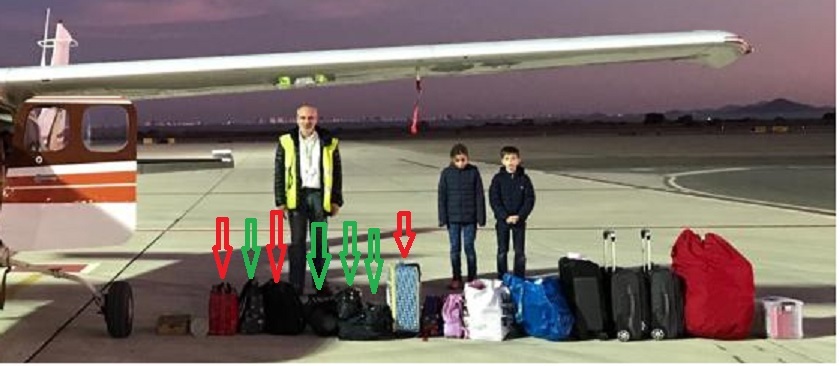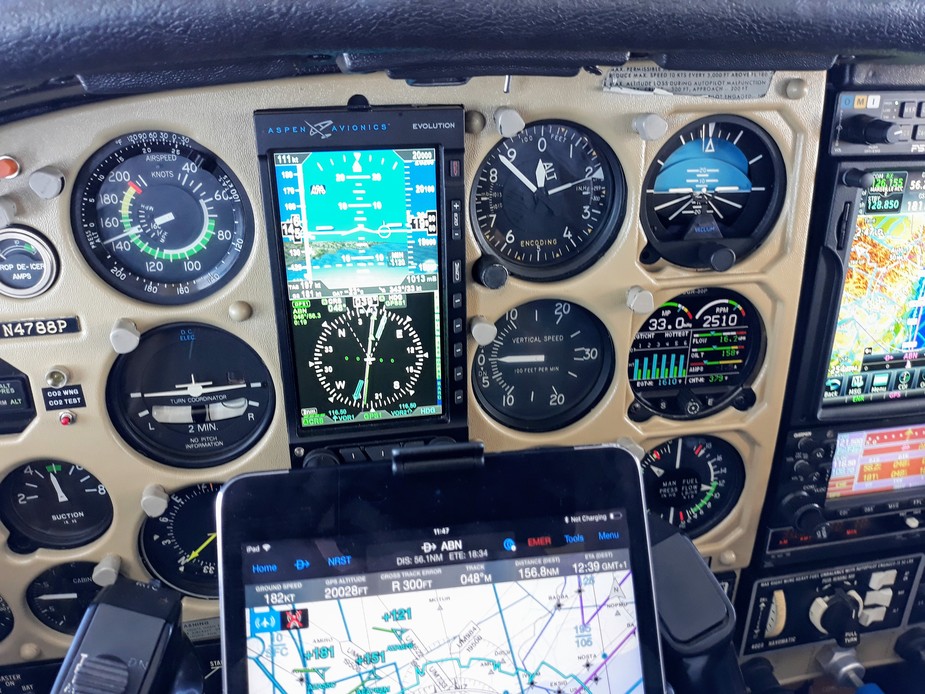Peter wrote:
I have to assume you removed some seats
No seats were removed. We did occupy one seat with luggage, but the other five seats had pax.
The items marked in red (one backpack, one suitcase and the liferaft), were on one seat fastened with a seatbelt.
The items marked in green were all on the floor: wifes handbag and one backpack under the seats, my flighbag and laptop bag on the floor.
The rest , together with a 29.4USG aux fuel tank (mostly empty this time), were all in the separate baggage compartment.
Total weight of what you see is about 70 kg.
Perhaps my wife took a pic of the inside…I’ll look it up.

Only one pic of the inside, but at least you can see we had no luggage on the feet or pax
boscomantico wrote:
don’t think P210s go much above 185, no? 190 if pushed hard above FL200 and with the cylinders glowing red… It also climbs like a dog and flies like a truck.
Yes and no. I guess there are P210’s and then there are P210’s.
Ours does 200KTAS at 16.5GPH LOP at FL200 up to ISA+10 at our typical mid-weights (300-400lbs under gross) (1100-1200lbs load).
About 207KTAS ROP at 25 GPH but I never fly like that.
ISA+20 means about 10KTS less. This is limited by available MP at altitude (depending on temp) , and the need to remain sufficiently LOP at least 70LOP and TIT<1650.
For endurance you can fly 8GPH at 110KIAS, but this figure is rather weight-dependant.
Climb at that weight is 650fpm average to FL140 up to ISA+15, then decreases with temp limited by CHT and max FF and related higher IAS. Not exactly a rocket but still quite decent. If flying lonely with mid fuel, 900fpm is more typical.
From then on it wanes down to 250-300fpm at the FL230 certified ceiling depending on temperature.
Average to FL180 at max gross is 500fpm or about 35 mins. At that weight, cruise is 5 kts slower, but even with our full 118USG (this is 7 hrs to empty including climb to FL200) that is 780lbs payload or four adults plus luggage (or three typical 140kg couples with light luggage and 5.3 hrs to empty at FL200)
I use 380F as target max CHT (#5 for me) , I take action if higher than 385 and have an alarm at 390.
Flies like a truck? Well, our Cardinal was much more manoeuvrable, but the 210 can still be manoeuvred around quite well.
Great for IFR but manoeuvring takes more effort and a lot of trim use.
Nothing similar beats a 210 in a crosswind landing, and a lot of them are regularly operated on grass which cannot be said of most other RG’s
Pic is a couple of weeks ago flying to LIMA Aeritalia

boscomantico wrote:
Even the world’s most experienced P210 pilot didn’t have all that many positive things to say about it. From the design POV, it was quite a nightmare, he said.
Mr Collins! I truly respect him. Yes he can speak with great authority on the P210. There is a lot of what may appear as negative stuff in this wonderful blog.
The fact is he thought he was getting a fully developed Cessna aircraft and instead he was used as a guinea pig by Cessna. They developed the airplane into a good one using his help, but the whole concept was a stretch all along and some people died on the way.
This is not very different from some of the greatest airplanes in history where teething issues were suffered at great cost (747, Concorde or 787 come to mind, althogh no fatalities with the latter). The difference was that with the P210 the aircraft was certified and sold to customers and one of them happened to act as the OEM test pilot while editing the best GA mag in America airing the whole process in an otherwise unprecedented way…
The 210 is a great capable airplane (huge payload, fast, high, grass capable…) but was born in the sixties in unpressurized fashion. To keep it short the development into the P210 was a stretch and thus the design ended up being suboptimal from an engineer’s point of view, to say the least. As an example why would you place a hydraulic actuator inside the pressure vessel when the actuated item is outside, with all the attendant problems? Because that was the configuration in earlier 210’s where such configuration had been troublefree for hundreds of thousands of hours, and it was easier to install a cabin pressure seal in an awkward function and location than to change the whole LDG configuration.
Having said that, there are several things that make the technical issues raised by Richard Collins much smaller now than they seem to be in his blog:
On the other hand, any single-engine pressurized airplane operated in private hands can be a handful. Some TBM’s and quite a few PA-46’s have also fallen out of the sky. More then than now, there is a lack of knowledge in the pilot community about the requirements of this type of operation and this forced some changes in the aircraft that the whole industry benefited from (ie multiple AI’s with independent sources, airloads in typical high-altitude ops…). Some of these items were not type-dependant, they were only the result of a different type of operation that the new airplane’s capabilities brought further and more often (ie Bonanza partial panel accident)
I can think a of a lot more details but they belong in the P210 thread (perhaps this too?)
The PA-46 is a much better airplane from an engineering standpoint (the engine compartment is a mechanic’s dream compared to the P210 nightmare) , but still suffered from the same lack of understanding in the community killing not only some POB but also the Continental-engined version and making the Mirage a gus-guzzler in comparison.
Bottom line is: a P210 will always be difficult to maintain and fly and is not for everyone. It is not an airplane to leave in the hands of your mechanic with no owner involvement. If you ensure it is maintained, configured (multiple AI’s, SB’s…) AND operated properly then it can be very reliable despite the complexity, still way cheaper to operate than a PA-46, while being hard to beat in performance and capability.
Congrats, this one does seem to perform well indeed. Yes, a well set-up and flow-balanced engine can really make things a bit better than in the the old books.
I just really didn’t like the truck-like handling, meager climb performance and the old-school cabin (that said, I don’t like the Malibu much, either). Of course, in the hands of the right person, it can be the right airplane, but it’s not a technological marvel. Occasionally, pilots (usually those who have never flown in one) write on the internet that it is their “dream plane”, thinking that it is some kind of mini-airliner with operating costs simliar to other touring SEPs, and of course, both are only true to a very limited extent.
I fly a NA C210 (club airplane) and occasionally a friend’s P210. While you couldn’t accuse the airplane of climbing like the proverbial ‘homesick angel’, it does what it’s supposed to do really well, namely touring. They are both extremely stable and – to me – a joy to fly. The P210 really is a micro-airliner, we (three friends) have done a couple of 1000nm trips (with fuel and coffee break) in it and pressurization simply changes everything, as it makes life one hell of a lot more comfortable. That said, while our club 210 needs what I would call ‘normal club ops’ attention (I’m comparing this to our C182 and two C172s), my friend’s P210 does seem to require quite a bit of maintenance. WRT the ‘truck-like’ handling – well, if I wanted to fly acros, I’d fly a Pitts or somesuch. A C210 isn’t made for it.
Back to the OP’s question: I think for the rather short legs he has in mind, a P210 might be a bit of overkill, however a T210 or NA 210 would tick pretty much all the boxes.
PS: there’s one downside to the P210: the baggage compartment is outside the pressure vessel and therefore rather short. I don’t think you can load skis or similar long stuff in there.
172driver wrote:
Back to the OP’s question: I think for the rather short legs he has in mind, a P210 might be a bit of overkill, however a T210 or NA 210 would tick pretty much all the boxes
I think so too: the T210FG aka T206 is the better airplane for the mission.
Why the T? The mountain mission
Apart from quicker selling potential what’s better about a 206/210 vs. a 207?
Just had a closer look at the pics of the OP’s 207. The rear clamshell doors have the quick-release mechanism. Now, this is a good thing inasmuch, as you can get rid of the doors in an instant and use it a photo ship (works great for that, btw!) or for meat bombing. OTOH, this may well imply that it was used for the latter activity, with all the concomitant shock cooling issues.
Why not consider a nice Partenavia P68?
For example: http://www.planecheck.com/index.asp?ent=da&id=41167&cor=y
